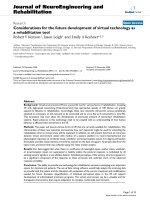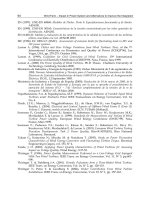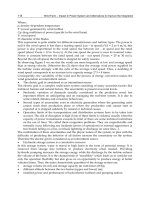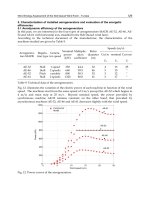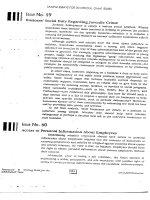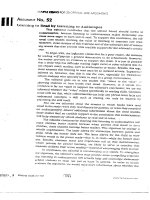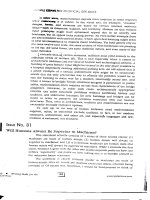Adamsen, Paul B. - Frameworks for Complex System Development [CRC Press 2000] Episode 2 Part 4 doc
Bạn đang xem bản rút gọn của tài liệu. Xem và tải ngay bản đầy đủ của tài liệu tại đây (47.78 KB, 5 trang )
©2000 CRC Press LLC©2000 CRC Press LLC
appendix E
Mapping EQFD and Robust
Design into the SDF
For those interested in applying Robust Design and Quality Function
Deployment (QFD) techniques into their engineering processes, the basic
steps of each have been mapped into the SDF.
69
This mapping is not to be
taken as absolute, but as a guide as to how those activities might be inte-
grated into the overall framework.
I. Requirements Development
A. Inputs
B. Work Generation Activities
1. Derive Context Requirements
• Identify all mission phases, modes, and states
• Develop mission timeline and operations concept
• Identify all external interfaces by mission phase
• Identify critical issues by mission phase (events, technologies, etc.)
• Define environments by mission phase
• Room 2: Context definition: Corporation
– Analyze full life cycle (EQFD 8-9)
70
– Preliminary noise source identification
2. Generate Functional Description
Develop and validate the functional description of the system. Determine if
the specification(s) is (are) complete and self-consistent.
69
The EQFD activities were drawn from Clausing, Don, “Total Quality Development,” ASME
Press, 1994. The Robust Design activities were drawn from Madhav S. Phadke, “Quality Engi-
neering Using Robust Design,” Prentice Hall, 1989.
70
EQFD is Enhanced Quality Function Deployment, as defined by Clausing.
©2000 CRC Press LLC
• Identify all functional requirements flowing out of imposed and
derived requirements
• Determine performance requirements of each function and the rela-
tionships (interfaces, interdependencies, etc.) between functions
• Tool for specification validation by simulation
• Define preliminary ideal function — signal-to-noise
C. Rework Discovery Activities
1. Analyze Requirements
Determine fidelity of the input or imposed requirements.
• Room 1: Requirements capture: Customer (EQFD 1-7)
– Identify all customer and user requirements
– Analyze for completeness, consistency, conflicts, etc.
Determine if all imposed and derived requirements are verifiable.
• Determine where in the system build-up each requirement will be
verified
• Determine Verification method (test, analysis, demonstration, simu-
lation, inspection)
• Verifiability (EQFD 10)
• Analyze value & Rooms 3, 6, 7: EQFD customer analyses
• Rooms 4 & 5 benchmarking — see Section II
• Room 8: Alternatives and priority definition — See Section II
2. Analyze Functional Description
• Determine if the specification(s) is (are) complete and self-consistent
• Identify all functional requirements flowing out of imposed and de-
rived requirements
• Determine performance requirements of each function and the rela-
tionships (interfaces, interdependencies, etc.) between functions
II. Synthesis
A. Work Generation Activities
1. Design
• Parametric analyses
• New technologies and heritage designs are surveyed for applicability
• Identify benchmark products
• Customer competitive survey (EQFD 13, Room 4)
©2000 CRC Press LLC
• Corporate measures (EQFD 14, Room 5)
• Orthogonal arrays — variation, value-of-performance
• Select critical design parameters: Fault trees, etc.
• Define feasible alternate design values (Product Parameters Design
Step 2; EQFD 19, Room 8)
• Select areas for concentrated effort (Product Parameter Design Step
3; EQFD 20, Room 8)
• Block diagrams, schematics, drawings, etc.
• Tolerance design — quality loss function, precision vs. cost vs. quality loss
• Process parameter design
• Technical performance, cost, schedule
• Preliminary mitigation approaches
2. Allocation
a. Allocate: functionality, performance, constraints, etc. to system
H/W and S/W elements
b. Define preliminary budgets
• Technical: mass, power, throughput, memory, RF links, etc.
• Cost
• Schedule
• Risk, reliability, contamination, etc.
c. Margin and contingency rules
• Define rules
• Implement in Budgets
d. Define/refine technical performance measures (TPM)
3. Analysis
a. Mission, system, electrical, digital, analog, RF, mechanical, etc.
b. Simulations
c. FMECA (Failure Modes Effects and Criticality Analysis)
4. Functional Decomposition
• Decompose in single level increments
• Identify interfaces between next-tier elements
• Generate functional model
• Generate lower-level specification(s)
• Validate lower level specs
• Generate interface control document(s)
©2000 CRC Press LLC
5. Integration
e. Update design definition
• Update mission timeline
• Operations concept
• Block diagrams, schematics, drawings, layouts
• Identify and characterize interfaces
• Budgets, etc.
• Risk management — update risk identification, assessment, and
mitigation approaches
f. Configuration management
• Configuration control board (CCB)
• Specifications
• Interface control document(s)
• Databases, etc.
g. QFD and Robust Development
• Refine ideal function definition
• Refine critical parameter design, tolerance design, process parameter
design, etc.
B. Rework Discovery Activities
1. Analyses, Development Testing, Test Planning
These involve any and all analyses necessary to ascertain technical, cost,
schedule, robustness, and risk performance of the system. Note that the
“Impose Noise and Evaluate” activity is considered an essential element of
the Engineering Technical Process.
• Mission, system, electrical, digital, analog, RF, mechanical, etc.
• Impose noise and evaluate (Product Parameters Design Step 4 & 5)
• Analyze benchmark products:
– Customer competitive survey (EQFD 13, Room 4)
– Corporate measures (EQFD 14, Room 5)
2. Producibility, Testability, and Other Specialty
Engineering Activities
• Is the design testable within resource and time constraints?
• Is the design producible within resource and time constraints?
©2000 CRC Press LLC
• Is the design acceptable with respect to EMI/EMC, reliability, main-
tainability, affordability, supportability, etc. parameters?
• Evaluate technical difficulty (EQFD 18, Room 7)
III. Trade Analyses
The definition of which specific activities should be included under the broad
heading of “trade analyses” varies in the literature. The SDF places trade
analyses at the end of the process (recall discussion in Chapter 5, page 84),
because cost, schedule, technical, and risk parameters must be developed in
order to make a selection. Thus, while many elements of QFD and robust
design impact trade analyses, none are included under this heading since
they occurred previously.
